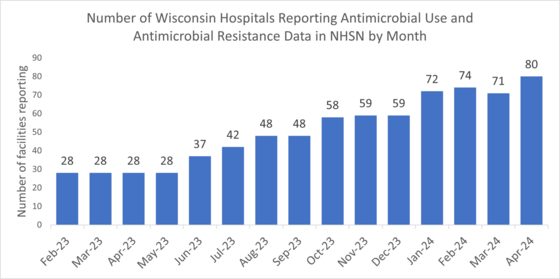|
This message is being sent to local public health department officers, nurses, and staff; Tribal health directors; infection preventionists; NHSN users; and key DPH staff.
HAI Happenings highlights new and noteworthy topics for all things related to healthcare-associated infections (HAI), including infection prevention and control (IPC), antimicrobial stewardship (AS), antibiotic resistance (AR), surveillance, and more. You will also be able to find links to helpful guidance and resources and learn more about current Wisconsin HAI Prevention Program activities.
Knowledge check
Test your knowledge. See the end of the newsletter for the answer.
When implementing enhanced barrier precautions (EBPs) in nursing homes, is physical or occupational therapy considered a “high-contact” care activity?
|
|
 |
What's new with the HAI Prevention Program?
-
A newly updated version of our IP Starter Kit is out! This interactive, web-based “starter kit” provides IPs with background information, tips, and resources such as templates, tools, and guides. This kit dives into topic areas applicable to all IPs across the continuum of care including:
- Infection Prevention Facilitated Discussion Guides have been released to help local and Tribal health departments (LTHDs) and others facilitate short, focused educational discussions on various infection prevention topics. Check out guides on antimicrobial stewardship, enhanced barrier precautions, infection risks, and more!
- Newly updated multidrug-resistant organism (MDRO) fact sheets are now available. See the health care focused fact sheet for frequently asked questions and steps to preventing the spread of MDROs. A similar fact sheet for families and residents is also available in Spanish and Hmong.
In the news
Notes from the field
Estimates of Wisconsin hospital engagement in antimicrobial use and resistance (AUR) reporting in the National Healthcare Safety Network (NHSN). Wisconsin acute care and critical access hospitals appear to be well on track to meet a new requirement under the CMS Promoting Interoperability (PI) Program to be in active engagement with NHSN to submit AUR data:
- Just over 90% of Wisconsin acute care and critical hospitals have registered their intent in NHSN to submit AUR data to fulfill the CMS PI Program AUR surveillance measure.
- The number of Wisconsin hospitals reporting both antimicrobial use and antimicrobial resistance data in NHSN has increased steadily since early 2023.
- About half (52%) of acute care and critical access hospitals submitted both antimicrobial use and antimicrobial resistance data in NHSN for each month from January through April 2024.

Best practice and guidance updates
- The Centers for Medicare and Medicaid Services released Memo QSO-24-08-NH stating new guidance for state survey agencies and long-term care facilities regarding the use of EBPs with residents who meet EBP criteria. The new guidance will be incorporated into F880 Infection Prevention and Control.
- The HAI Prevention Program launched a new webpage outlining infection prevention best practices in ambulatory care settings. The webpage highlights infection risks specific to ambulatory setting types, such as urgent cares, clinics, hospitals, and more. The page also includes resources for health care providers and patients and their families.
- The Division of Public Health Legionellosis update for testing and public health recommendations to prevent the spread of Legionnaires' disease has been distributed.
Project Firstline spotlight
The Wisconsin HAI Prevention Program is a CDC Project Firstline partner. Project Firstline provides innovative and accessible IPC education for frontline health care workers, including nurses, certified nursing assistants, environmental services staff, and allied health professionals. Educational resources offered through Project Firstline are available in a variety of formats to meet the diverse learning needs of the health care workforce.
New look!
HAI Prevention Program highlights
Infection Preventionist Bootcamp
This April and May, the HAI Prevention Program hosted the Spring 2024 Infection Preventionist (IP) Bootcamp. Two virtual and two in-person training sessions were held to train and engage IP staff across the state. Over 100 IPs from various care settings participated in the Spring IP Bootcamp. Be on the lookout for an announcement regarding our next IP Bootcamp offering!
Interested in learning more about IP Bootcamp? Contact the HAI Prevention Program Onboarding IP, Ashley O'Keefe (ashley.okeefe@dhs.wisconsin.gov).

Interested in receiving updates specific to your care setting?
Complete our brief survey.
You can now specify which health care setting type(s) you'd like to receive email updates on. If you're interested in receiving email messages specific to your care setting, please complete our brief survey.
|
Knowledge check
It depends! Depending on the activity, therapy may be considered “high-contact” care. It’s recommended that therapists use gown and gloves when working with residents on EBPs, whether in the therapy gym or in the resident’s room, if they anticipate prolonged close contact. While generally discouraged, there may also be individual instances when a therapist may need to utilize PPE in hallways or other common areas depending on the therapy activity and the type of assistance or close contact. Facilities should conduct an evaluation to determine appropriate and necessary PPE use for these circumstances. It’s important to remember that EBPs should not limit a resident’s ability to receive medically necessary care, including physical and occupational therapy.
|